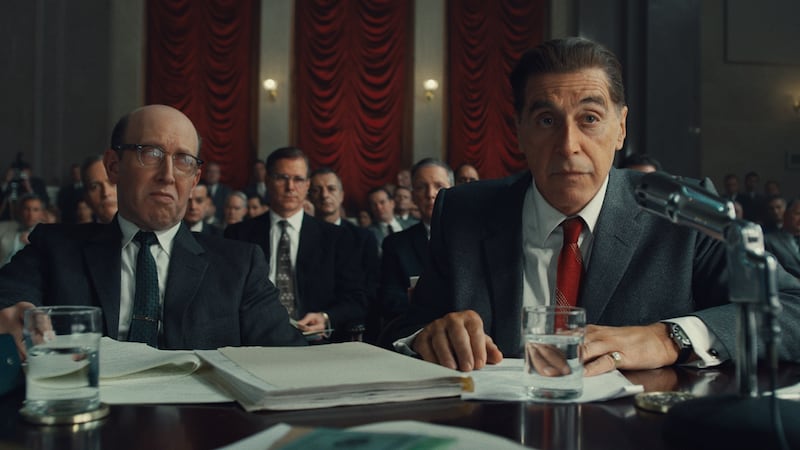As you can imagine, it's a bit weird watching Martin Scorsese's latest masterpiece when your name is Frank and "Irishman" is part of your job description. I hasten to add that any similarities between me and the homicidal mobster Frank Sheeran (played in the film by Robert De Niro) end there – or nearly.
There is also the fact that since last January, for no good reason, I have been learning Italian, via the computer app Duolingo. And as portrayed by Scorsese, it's partly because Sheeran could also speak that language, from his time in Italy during the war, that he bonded so well with the senior Mafia figure, Russell Bufalino (played by Joe Pesci).
Being Irish, of course, he could never become one of i fratelli (the brothers, as we Italophones say). So in the film, the Pesci character adopts him as a sort of figlio instead. On the occasions when they lapse into addressing each other in Italian, I felt an added level of conspiracy.
At a running time of 3 hours 20 minutes, The Irishman had seemed a daunting prospect for a Saturday matinee show. Compared with the likes of Goodfellas, it’s also quite a slow-paced film.
Given that it's based entirely on the lives of real people, The Irishman may be more convincing than it deserves to be
Early on, I briefly considered keeping a diary of the experience (an Irishman’s Diary, obviously) to pass the time (eg: “3.10pm. Madre di Dio! The guy behind me is munching popcorn again. I need a gun!”) But like Pesci’s career-defining performance, the film becomes quietly riveting and stays that way. I was so absorbed in it by the end, I half expected the Feds to be waiting for me outside.
Given that it’s based entirely on the lives of real people, in fact, The Irishman may be more convincing than it deserves to be. By his own account, which the screenplay takes on trust, Sheeran was a prolific killer-for-hire, responsible for two of the 20th century’s most notorious mob killings and for enough less famous murders to have lost count. Yet he did all this, apparently, without ever attracting serious suspicion, until his own deathbed revelations. Either he was blessed with Zelig-like talents for camouflage, or as doubters suggest, he made most of it up.
One of the most damning critiques so far has been by a man called Jack Goldsmith, a Harvard law professor, who in an essay for the New York Review of Book, dissected Sheeran's version of the Jimmy Hoffa murder in particular.
Goldsmith’s motivations include trying to clear the name of Charles “Chuckie” O’Brien, a long-time friend and aide of Hoffa, who according to “conventional wisdom since 1975”, repeated in the movie, drove the car that carried the corrupt but charismatic union leader to his doom.

The essayist admits a personal motive in this, because O’Brien is his “stepfather”. (It’s a small country, the US – everyone knows everyone else there). But he finds Sheeran’s admission of guilt “preposterous” and quotes well placed others who agree.
The second-most contentious claim of The Irishman is that he also did for “Crazy Joe” Gallo, the gangster gunned down while celebrating his birthday among family at Umberto’s Clam House, in Manhattan’s Little Italy, in April 1972.
That was the quintessential Mafia assassination, wordlessly referenced in the closing sequence of The Sopranos among other places. And conventional wisdom there is that the killer was a short Italian, not a tall Irishman. But if Scorsese’s film takes liberties with the story, it’s not the first time a major artist has done that.
While in many respects your average thug, it seems, Crazy Joe was considered by some people to be a cut above the rest. In jail during the 1960s, he read Tolstoy, Kafka, and the New York Times. Once out, he took to hanging out with society figures who found him charming.
Among those who fell for his legend retrospectively were Bob Dylan and his then collaborator Jacques Levy, who after hearing about the dead mobster from a friend, wrote the song Joey, for the album Desire. Despite being the ballad equivalent of a three-hour film (12 minutes), it was written in a single night, and portrays Gallo as a cross between Robin Hood and Mother Teresa.
The great music critic Lester Bangs called it "one of the most mindlessly amoral pieces of romanticist bullshit ever written". Bangs also took the trouble of answering the poetic question posed in the chorus: "What made them want to come and blow you away?"
As the Irishman agrees, what made them want to do that was probably the whack job Gallo had organised on one of the heads of the “Five Families”, in broad daylight, some months earlier.










